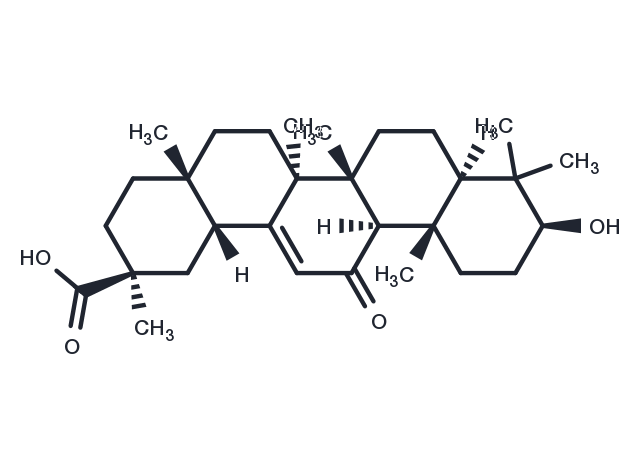Powder: -20°C for 3 years | In solvent: -80°C for 1 year


18β-Glycyrrhetinic acid (Enoxolone) is the major bioactive component of Glycyrrhizae Radix and possesses anti-ulcerative, anti-inflammatory and antiproliferative properties.

| Pack Size | Availability | Price/USD | Quantity |
|---|---|---|---|
| 500 mg | In stock | $ 43.00 | |
| 5 g | In stock | $ 61.00 | |
| 1 mL * 10 mM (in DMSO) | In stock | $ 48.00 |





| Description | 18β-Glycyrrhetinic acid (Enoxolone) is the major bioactive component of Glycyrrhizae Radix and possesses anti-ulcerative, anti-inflammatory and antiproliferative properties. |
| In vitro | MTS assay demonstrates that 24 h treatment of Enoxolone suppresses cell proliferation in both cell lines in a dose-dependent manner. Enoxolone at 160 μM significantly decreases the percentage of viable cells to around 40.5±10.5% in A549 and 38.3±4.6% in NCI-H460 (p<0.01 respectively). When the cells are treated with 320 μM Enoxolone, a greater inhibitory effects on cell proliferation is shown, as the percentage of viable cells is below 30% compare with untreated controls (p<0.001). Treatment with Enoxolone at 160 μM and 320 μM decreases the levels of full-length PARP and increases the levels of cleaved-PARP. |
| In vivo | Rats in Enoxolone+Triptolide (TP) group which receive low-dose Enoxolone (50?mg/kg) have significant reductions in the three serum parameters when compare with TP rats. Rats in Enoxolone+TP group which receive the high-dose Enoxolone (100?mg/kg) have slightly lowered the levels of three liver enzymes, the reductions do not reach statistical significance compare with TP group. Contrastingly, preadministration of low-dose Enoxolone protects animals from TP-induced hepatic lesions. On the contrary, low-dose Enoxolone (50?mg/kg) markedly suppresses the release of the four cytokines above. |
| Source |
| Synonyms | Enoxolone, Glycyrrhetin |
| Molecular Weight | 470.68 |
| Formula | C30H46O4 |
| CAS No. | 471-53-4 |
Powder: -20°C for 3 years | In solvent: -80°C for 1 year
H2O: < 1 mg/mL (insoluble or slightly soluble)
Ethanol: < 1 mg/mL (insoluble or slightly soluble)
DMSO: 87 mg/mL (184.8 mM)
You can also refer to dose conversion for different animals. More
bottom
Please see Inhibitor Handling Instructions for more frequently ask questions. Topics include: how to prepare stock solutions, how to store products, and cautions on cell-based assays & animal experiments, etc.
18β-Glycyrrhetinic acid 471-53-4 Metabolism Dehydrogenase Endogenous Metabolite Enoxolone Inhibitor 18b-Glycyrrhetinic acid 18β Glycyrrhetinic acid 18βGlycyrrhetinic acid inhibit Glycyrrhetin 18beta-Glycyrrhetinic acid inhibitor
